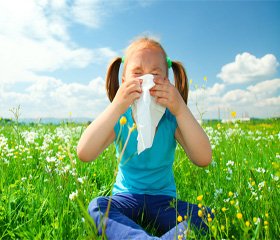Журнал «Здоровье ребенка» 8 (51) 2013
Вернуться к номеру
A New Look at the Mechanisms of Remission Induction of Allergic Diseases in the Treatment with Allergens
Авторы: Nedelska S.M., Yartseva D.O., Marchuk N.M., Datsenko O.M. - Zaporizhya State Medical University, Department of Faculty Pediatrics, Zaporizhya, Ukraine
Рубрики: Педиатрия/Неонатология
Разделы: Справочник специалиста
Версия для печати
Nowadays allergic diseases take an important place in a variety of childhood diseases, as they not only worsen patients’ lives, but are also associated with a significant economic burden set upon the state and the diseased.
As you know, the main target of pharmacological agents in chronic allergic diseases treatment — is the inflammation of mucous membranes or skin. Allergic inflammation has its own characteristics and is mediated by many cells and mediators. The contact with an allergen (such as pollen) starts the following event sequence, which induces the blennosis of the upper respiratory system or bronchi (mostly). Pollen reaches the mucous membrane and due to permeability factor passes through the epithelium, swells up, bursts; blood and lymph absorb its content thus provoking immune response. The first contact with an allergen prepares the mucous membrane for the following ones, making it more sensitive. This phenomenon is called «priming effect». As a result with the next provocation of mucous membrane the amount of pollen particles, required for the symptoms of hay fever, decreases in a few dozen times. Priming phenomenon explains the symptoms without presence of the main trigger and leads to a «minimal persistent inflammation» of mucous membrane, which remains for several weeks after allergenic provocation even if the patient is receiving anti-inflammatory therapy.
There are two possible ways of cell death in human organism — apoptosis and necrosis. The common development stage for them is DNA degradation. Necrosis — is not programmed, pathological form of cell death that occurs in response to severe cellular damage and is attended with classical symptoms of inflammation. Apoptosis — is energy-dependent process that is activated due to genetically programmed cell death.
Apoptosis-involving diseases are divided into 2 groups — due to deceleration and acceleration of the aforementioned. Allergic diseases are accompanied by inhibition of pneumonoconiosis, declaring themselves in lungs by inflammation persistence, epithelial disorganization and increasing fibrosis of tissues. Apoptosis regulation mechanisms are quite complex and almost haven’t changed in course of evolution, underscoring its fundamental biological part.
Two consecutive processes occur in cell after receiving the "death"-signal and sometimes even without appropriate signal: one in membrane involving death receptors and the other in cytoplasm due to specific enzymes (caspases) activation, which leads to DNA damage and as a direct result to apoptotic cell death.
Therefore, the aim of our work is to research the characteristics of Fas / FasL-mediated apoptosis and expression of a soluble form of IL-13Ra2 receptor during children’s hay fever depending on its clinical variant and to evaluate changes of systems when treatment regimen includes allergenspecific immunotherapy (ASIT).
The essential effect of ASIT — is the induction of clinical and immunological tolerance to specific allergens. This is possible due to prolonged desensitization involving mechanisms that change allergenspecific memory of immune cells. There are some materials in the literature, concerning the therapy effect to level changes of Fas-receptor's soluble forms. Thus, children having allergen diseases of pollen aetiology had significantly increased level of Fas-receptor after clinically successful courses of ASIT with causative allergens.
Under our observation there were 104 children with hay fever who agreed to participate in the study. Bronchial asthma (BA) in combination with rhinoconjunctivitis (seasonal allergic rhinitis — SAR/seasonal allergic rhinoconjunctivitis — SARC) was detected in 77 (74.04 %) of them. These children formed the first group. Others left 27 (25.96 %) children with diagnosed isolated ASRC/ASR — formed the second group. The control group (group 3) consisted of 18 healthy children. Children making these groups were of the same gender, age and disease duration.Study results confirm the protective role of ASIT with causative allergens concerning the level increase of IL-13Ra2, which blocks the activity of proinflammatory mediator IL-13.
Thus, ASIT reduces allergic inflammation by provoking the apoptotic death of immune cells that are involved in the inflammatory process. Based on these data we can say that the changes occurred in the course of ASIT with weed pollen a year after this therapy are quite noticeable, but still insufficient for an adequate activation of apoptosis processes and complete inflammation elimination. This fact confirms the necessity of ASIT within a few years. ASIT duration and number of therapy regimens are to be determined, which makes the aim of our further work.

